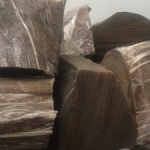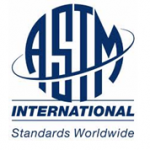

As discussed in our previous Blog about Natural Rubber, it can extremely difficult to tell the difference between high grade rubber casters and a medium or low grade rubber casters. After all, most rubber looks pretty much the same, however in the case of Rubber Caster Wheels, whilst the appearance may be the same there could be many significant differences that affect the performance and life of the Casters wheel, for example Abrasion & Wear Resistance, Compression Set, Creep, Resilience, Hysteresis (Heat Build Up) to name a few.
Considering the above fact, it is important that when specifying a Rubber Caster Wheels Mechanical Properties and grade that a complete specification is defined, allowing the products mechanical properties to be controlled.
 The American Society of Testing and Materials (ASTM) have developed an International Standard for specifying the mechanical properties of Vulcanised Rubber Products, such as Caster Wheels, Rubber Mouldings & Industrial Rubber Goods. This standard is called ASTM D 2000: Standard Classification System for rubber products.
The American Society of Testing and Materials (ASTM) have developed an International Standard for specifying the mechanical properties of Vulcanised Rubber Products, such as Caster Wheels, Rubber Mouldings & Industrial Rubber Goods. This standard is called ASTM D 2000: Standard Classification System for rubber products.
The ASTM D2000 standard can be used to specify almost any mechanical property, including the specifying Rubber Caster Wheels Mechanical Properties. The specification is given as a “code”, called a “Line Call Out” which details the required mechanical properties. This code can be provided to manufacturers and noted on drawings and specification documents. All Rubber Based Caster Wheels can be defined by “Line Call Out” specification.
The ASTM D2000 Line Call Out is also extremely useful for Quality Testing and Inspection purposes, as all parts of the defined specification can be tested and measured to ensure they conform. This may be an abrasion test of the Casters Rubber Wheels, or the resistance to a certain fluid or chemical.
A typical Line Call Out is specified below, where each part of the “code” defines a specific requirement. This would be a typical Line Call Out for a Black Rubber Caster Wheels Mechanical Properties, in which we will explain below in detail:
ASTM D2000 M 4 AA 7 14 A13 B13 C12 G21 Z1
How to read and ASTM D2000 Line Call Out
As discussed above, the Line Call Out specifies the Caster Wheels Mechanical Properties, its Test Method and corresponding property requirements. Below we will break down the above example Line Call Out into its separate parts, and describe their meaning:
ASTM Standard Reference
ASTM D 2000 M 4 AA 7 14 A13 B13 C12 G21 Z1
The “ASTM D2000” part of the code specifies which ASTM standard is being used. In this case it is the ASTM D2000 – Specifying Mechanical Properties for Rubber Products
Units of Measurement (Metric/Imperial)
ASTM D2000 M 4 AA 7 14 A13 B13 C12 G21 Z1
The ‘M’ indicates Metric units (for example MPa). If the “M” is not present it indicates imperial measurements (for example PSI).
Grade of Requirements
ASTM D2000 M 4 AA 7 14 A13 B13 C12 G21 Z1
The Grade Number, in this case “4” indicates the allowable deviation of mechanical properties after a test (for example, a maximum change of the rubber hardness of the wheels tires after a fuel immersion test).
Material – Heat Resistance
ASTM D2000 M 4 AA 7 14 A13 B13 C12 G21 Z1
The first letter of the 2 digit reference, in this case an “A”, specifies the required Heat Resistance of the Rubber Caster Wheels tire, according to ASTM D573. This specification relates to a constant temperature that the rubber wheel must withstand, in this case 70°C and must not be confused for a materials resistance to short term temperatures. In the case of Castor Wheels, the majority of applications will require no more than “A” or “70°C”, however our Polymer based Casters can accommodate above 350°C.
The letters below show the related temperature requirements:
A = 70°C
B = 100°C
C = 125°C
D = 150°C
E = 175°C
F = 200°C
G = 225°C
H = 250°C
Material – Oil Resistance
ASTM D2000 M 4 AA 7 14 A13 B13 C12 G21 Z1
The second letter of the 2 digit reference, in this case also an “A”, specifies the required Resistance to Oil (IRM 903 Oil) according to ASTM D471, where the rubber casters wheel is submersed in the oil for a set period of time (70 hours) and at a controlled temperature, after which the amount of swell is measured. This can be important where the equipment is used in an area where contaminants are present, such as a Tool Trolley on Casters in an Automotive Workshop.
The letters below show the related maximum oil swell percentage:
A – No Requirement
B – 140% Swell
C – 120% Swell
D – 100% Swell
E – 80% Swell
F – 60% Swell
G – 40% Swell
H – 30% Swell
J – 20% Swell
K – 10% Swell
Material Designation (Type and Class)
ASTM D2000 M 4 AA 7 14 A13 B13 C12 G21 Z1
The Temperature & Oil Resistance as specified in points 4 & 5 above will dictate the available polymer type that is used for the wheel. Whilst the standard does not always specify the exact polymer, the requirements of Temperature & Oil Resistance narrow down the choice of materials. Therefore whilst a Line Call Out may not specify the exact material, it generally narrows the options as follows:
AA – Natural rubber, Reclaimed Rubber, SBR, Butyl, EP Polybutadiene, Polyisoprene
AK – Polysulfides
BA – Ethylene propylene, high-temperature SBR and Butyl compounds
BC – Chloroprene polymers (Neoprene), cm
BE – Chloroprene polymers (Neoprene), cm
BF – NBR polymers
BG – NBR polymers, Urethanes
BK – NBR
CA – Ethylene Propylene
CE – Chlorosulfonated Polyethylene (Hypalon), cm
CH – NBR polymers, Epichlorohydrin polymers
DA – Ethylene propylene polymers
DE – CM, CSM
DF – Polyacrylic (Butyl-Acrylate type)
DH – Polyacrylic polymers, HNBR
EE – AEM
EH – ACM
EK – FZ
FC – Silicones (High Strength)
FE – Silicones
FK – Fluorinated silicones
GE – Silicones
HK – Fluorinated elastomers (Viton, Fluorel, etc.)
KK – Perfluoroelastomers
In the case of Black Rubber Casters, these are generally specified with the “AA” designation, using a Blend of Natural Rubber & SBR (Similar to an Automotive Car Tire). Where Other requirements are required, such as Oil Resistance then the Caster Wheel manufacturer may use a “BC”, Chloroprene rubber wheel.
Rubber Hardness
ASTM D2000 M 4 AA 7 14 A13 B13 C12 G21 Z1
The next digit, in this case a “7” specifies the hardness of the Rubber. Rubber hardness is measured using the Shore A Scale, as specified by ASTM D2240. In order to obtain the required Shore A Hardness, the digit (for example “7”) is multiplied by 10, giving the Shore A Hardness. In this instance 70 Shore A. The Tolerance is typically +/- 5 shore unless otherwise specified. The Shore Hardness is important for Caster Wheels, as it determines the “roll resistance”, “Shock/Impact Resistance” and “Wear resistance”
Rubber Tensile Strength
ASTM D2000 M 4 AA 7 14 A13 B13 C12 G21 Z1
The next two digits specify the Minimum Tensile Strength of the rubber. As the Line Call Out is specified in Metric Units (represented by the “M” as explained above) the Tensile Strength is specified in MPa, so in this case 14 MPa. The Tensile Strength of a Caster Wheel has a direct correlation with the impact resistance of the wheel.
Caster Wheels Mechanical Properties – Type
ASTM D2000 M 4 AA 7 14 A13 B13 C12 G21 Z1
The remainder of the code is where the specific mechanical properties of the material are defined. Depending on the application where the Caster Wheels are being used, there may be various properties of the rubber tire that are required. The Letters (as underlined above) indicate the mechanical property to be defined (i.e. “A” = Heat Resistance) and relates to a specific testing method (“A” = ASTM D573 Test Method). For example, Compression Set, as defined by “B” is extremely important for Rubber Caster Wheels. High Compression set would result in the wheel taking permanent deformation if the wheel is left in the same position for a few days.
Each letter relates to a different type of mechanical property and corresponding test method, as follows:
A = Heat Resistance (ASTM D573)
B = Compression Set (ASTM D395)
C = Ozone or Weather Resistance (ASTM D1171)
EA = Fluid Resistance (Aqueous) (ASTM D471)
EF = Fluid Resistance (Fuels) (ASTM D471)
EO = Fluid Resistance (Oils and Lubricants) (ASTM D471)
F = Low Temperature Resistance (ASTM D2173)
G = Tear Resistance (ASTM D624)
J = Abrasion Resistance (ASTM D5963)
M = Flammability Resistance (defined by manufacturer)
P = Staining Resistance (ASTM D295)
Z = Special Requirements (specified by the manufacturer)
Note: The above ASTM test methods are examples only, and dependent on the grade of material and suffix numbers (as below) specify the exact Test method (for example ASTM D573, & ASTM D865 are both Heat Resistance test methods that may be applicable).
Caster Wheels Mechanical Properties – Method & Requirements
ASTM D2000 M 4 AA 7 14 A13 B13 C12 G21 Z1
The Suffix Numbers determine the Test Method and required results of the test. This is an extremely detailed part of the specification, which it outside of the scope of this Blog post. In order to review all test methods users should firstly purchase ASTM D2000 standard, and any relevant standards that they need to specify. Key Standards for Caster Wheels would be Compression Set, Resistance to Fluids and Temperature resistance. To give an example of one specification “A13”, which relates to Heat Resistance, ASM D573 which tests the material for 70 hours at 70 deg C, with Change in hardness (Max +10 shore), Change in Tensile Strength (Max -25%) and Change in Elongation (Max -25%)
Bulldog Castors Ltd – Unlike most of our competitors we employ Polymer Engineers to provide the best expertise in the design & manufacture of Caster Wheels. Bulldog also have in house testing to measure mechanical properties – Can your Caster Wheels Supplier offer the same?
Article: Caster Wheels Mechanical Properties of Rubber Products 2016. The above information is provided for guidance only. The accuracy of information is not guaranteed, and users should read the relevant ASTM standards to confirm information.